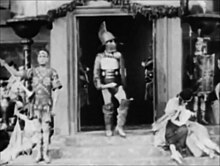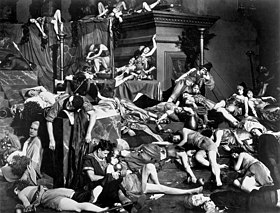Women on the wrong track
| Movie | |
|---|---|
| German title | Women on the wrong track |
| Original title | Manslaughter |
| Country of production | United States |
| original language | English |
| Publishing year | 1922 |
| length | (10 rolls ; 9,061 feet); 100 minutes |
| Rod | |
| Director | Cecil B. DeMille |
| script | Jeanie Macpherson |
| production | Cecil B. DeMille Jesse L. Lasky for Famous Players-Lasky and Paramount Pictures |
| camera | Leslie Guy Wilky , Alvin Wyckoff |
| cut | Anne Bauchens |
| occupation | |
| |
Women on the wrong track is a 1922 American silent film drama directed by Cecil B. DeMille and starring Thomas Meighan , Leatrice Joy and Lois Wilson . The screenplay was written by Jeanie Macpherson based on the novel by Alice Duer Miller .
action
The film shows the privileged life of the upper class during Prohibition in the United States . In his film Manslaughter, Cecil B. DeMille shows the jazz age and his pursuit of pleasure and cites the Roman Empire . In a flashback, drinking New Year's guests are transported from the present to ancient Rome, and a breathtakingly garish Roman orgy represents the destructive effects of gin , jazz and the fast-paced life of the Roaring Twenties . The main character Lydia becomes a Roman empress who leads and participates in the orgy, which is tellingly called the Bacchus Festival. The festival is enjoyed by scantily clad women, drunken revelers, and satyrs . The women get excited at the spectacle of the male gladiatorial fight. In the midst of this debauchery, bearded barbarians (the vandals ) with huge winged helmets arrive and rape, pillage and pillage. The message is clear: decadence and the ruthless pursuit of pleasure led to the end of the Roman Empire, and America of the 1920s awaits the same fate. "Not unlike Rome in the worst case," intones the district attorney, the voice of the law in the biblical, patriarchal sense. A disaster is avoided through moral renewal and the restoration of patriarchal authority: Lydia repents and marries the district attorney. In Manslaughter, DeMille used Rome's legendary decadence to illustrate the moral of jazz. At the same time, he offered his audience a voyeuristic insight into forbidden joys and desires.
Superlatives
The film was completed in 1922 when the post-censorship defamed by the film was replaced by the anticipatory censorship of the Motion Picture Producers and Distributors Association of America .

This film was one of the first to show a very graphic scene of men pillaging a room owned by high society women . Manslaughter was the first film to feature an erotic kiss between two members of the same sex.
A paradoxical interdependence between the censor and the censored became apparent in the 1920s when, in Cecil B. De Mille's biblical epics, insights into female nudity and in Fred Niblo (film director) Ben Hur (1925) the particularly colorful sequence of women with bare breasts added were waved through by the British Board of Film Censors (BBFC) without comment . The Motion Picture Producers and Distributors Association of America (MPPDA) founded by the heads of the major Hollywood film studios. As a representative of the interests of the film industry, it should enhance its image in society and counter the call for state censorship of films at the time. Its President William Harrison Hays , who had previously served as post office secretary in the cabinet of Republican President Warren G. Harding , attempted to forestall government interference by developing a system of self-censorship for the film industry, known as the Hays Code or Production Code , which continued until in the time after World War II lasted. Hays was succeeded by Eric Johnston as President of the MPPDA in 1945 . Under his leadership the organization got its current name.
production
The film production of this work took place at a time when filming on the set and in relation to the film crews was becoming demanding. Film production in terms of actors, producers, set designers , screenwriters , camera crews and lighting became more complex. It was a film made using continuity films where a scene is continued from different angles . Production costs amounted to 385 thousand USD . The producers were Cecil B. DeMille and Jesse L. Lasky. The film premiered on September 24, 1922
According to Leatrice Joy, filming the chase scene was extremely nerve-wracking as she had to drive the car herself, which was equipped with a platform that supported two cameramen and the director and equipment. Your safety depended entirely on your ability as a driver. Joy drove most of these chase scenes, her stunt double being Leo Nomis . While filming a prison sequence, Joy burned her hand on a soup kettle, and assistant director Cullen Tate had neglected to let her know that he was heating the prop kettle .
criticism
The film reviews created decades later found nothing commendable in the work. Kevin Brownlow characterizes the work as a banality , which documents Cecil B. DeMille's falling prey to commerce. Another view would be that his commercial talent consisted in recognizing and being able to satisfy the needs of the moviegoers.
"It is hard to believe that such a raw and unsubtle film could have come from a veteran like De Mille," said a 1963 Theodore Huff Society program note for the film Orphans of the Storm , Down to the Sea in Ships ( 1922 film) , and Foolish Women . The amateurish, crude animation of the car chases with which the film begins are less technically sophisticated than Sennett was ten years ago. Manslaughter is exactly the kind of film that the ignorant would consider typical of the silent film - reworked, played in pantomime, written in the manner of a Victorian melodrama, a kind of film that invites you to laugh more than to laugh along. "In one scene, Lydia provokes the vehicle accident by suddenly bringing her car to a standstill and a policeman with his motorcycle sustaining fatal injuries when colliding.
When William K. Everson showed a print of the film on the birthday of Joy's daughter Leatrice Joy Fountain (September 1924 - January 20, 2015), Joy was present and saw him for the first time in forty years. According to Kevin Brownlow, "Miss Joy thought it was funny."
State of preservation
Copies of the film are in the George Eastman House film archive and in the Paul Killiam Collection .
Remakes
- Manslaughter (1930)
- Reckless youth
Web links
- Manslaughter at Turner Classic Movies (English)
- Title in the All Movie Guide (English)
- Manslaughter_1922 as a complete film in the Internet Archive
- Manslaughter at Virtual History
- IMDb title: [8]
Individual evidence
- ↑ cast, [1]
- ↑ fast living, hard drinking, cf. Koock Elan Jung, (born May 1, 1942; February 12, 2018 Los Angeles), Sexual Trauma: A Challenge Not Insanity, [2]
- ^ The Sign of the Cross (November 30, 1932) was not Cecil B. DeMille 's first use of Rome as a site for spectacle and moral commentary on the present. In 1922, his film Manslaughter compared the Jazz Age and its pursuit of pleasure to ancient Rome. In a flashback sequence, modern New Year's Eve carousers are set in ancient Rome, and a stunningly lurid Roman orgy stands for the corrosive effects of the gin, jazz, and fast living of 1920s. The main character, Lydia, becomes a Roman empress who presides over and participates in the orgy, appropriately called a Feast of Bacchus. The Feast is enjoyed by scantily clad women and intoxicated revelers and satyrs, and the women become sexually aroused by the spectacle of male gladiatorial combat. In the midst of this debauch, bearded barbarians (the Vandals) wearing huge winged helmets arrive and proceed to rape, pillage, and plunder. The message is clear: decadence and the reckless pursuit of pleasure brought about the end of the Roman Empire, and 1920s America is inviting the same fate. "No different than Rome at its worst," intones the District Attorney, the voice of the Law in its biblical, patriarchal sense. Disaster is avoided through moral regeneration and the reestablishment of patriarchal authority: Lydia repents and marries the District Attorney! In Manslaughter, DeMille exploited Rome's fabled decadence to make a point about the morals of the Jazz Age and, at the same time, offered his audiences a voyeuristic glimpse of forbidden pleasures and desires. P. 190 , Arion, Trustees of Boston University, 2004 p.135 [3] [4]
- ↑ Alice Duer Miller | American author .
- ↑ Patrick Robertson: The Guinness Book of Movie Facts & Feats . Abbeville Press, 1993. To the right of the door, two women sit on stairs, clutch each other, kiss, and laugh (fig. 22)., One sits on a lower step and presses her head to the other's bosom. Both wear togas p.130
- ↑ This paradoxical interdependency between censor and censored became more evident in the 1920s, when glimpses of female nudity in Cecil B. De Mille's biblical epics and the specially colored-tinted sequence of bare-breasted women in Fred Niblo's precociously camp Ben Hur (1925) were passed without comment by the board.
- ↑ a b c History of the MPAA www.mpaa.org (accessed on January 7, 2013)
- ↑ [5]
- ↑ Joseph P. Magliano, Jeffrey M. Zacks: The Impact of Continuity Editing in Narrative Film on Event Segmentation . In: Cognitive Science . 35, No. 8, November 2011, ISSN 0364-0213 , pp. 1489-1517. doi : 10.1111 / j.1551-6709.2011.01202.x . PMID 21972849 . PMC 3208769 (free full text).
- ^ Progressive Silent Film List: Manslaughter . In: Silent Era . Retrieved May 2, 2008.
- ↑ a b Brownlow, K .; The parade's gone by ...; University of California Press, 1976; p. 185
- ↑ Leo Nomis (born May 5, 1889 in Iowa ; † February 5, 1932 in Los Angeles ) Involved in 1930: The Dawn Patrol , 1916: Intolerance (film) and 1932: Sky Bride .
- ↑ Movies Silently, Manslaughter (1922) A Silent Film Review, November 27, 2016 [6]
- ↑ a b c The Cheat is one of those rarities - a film to shock that retains its artistic integrity. Between The Cheat and a film about the banality of Manslaughter (1922) lies a commercial divide in which a great talent perished .; The Cheat is one of those rarities - a film designed to shock which retains its artistic integrity. Between The Cheat and a film of the banality of, say, Manslaughter (1922) lies a chasm of commercialism in which a great talent perished. Manslaughter is thought of by historians as one of De Mille's lesser efforts as a director. Historian Kevin Brownlow notes that Joy and Wilson "both give far better performances than the film deserves." Brownlow, K .; The parade's gone by; University of California Press, 1976; P. 180
- ↑ youtube , [7]





